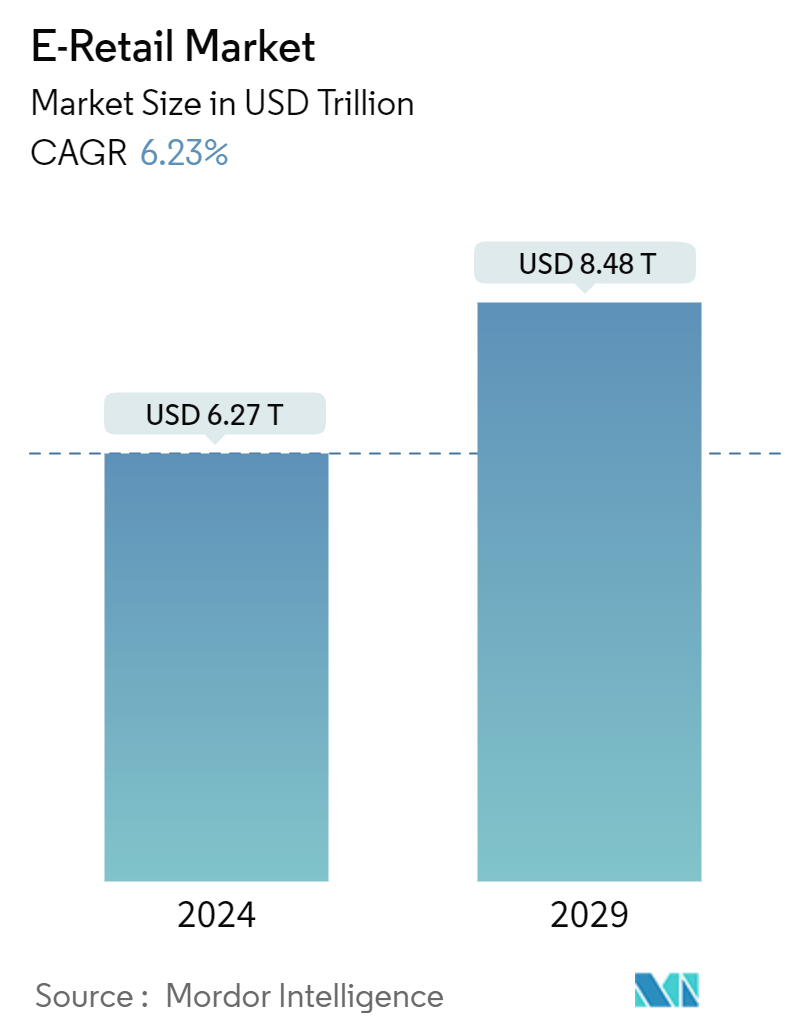Market Size of E-Retail Industry

| Study Period | 2020 - 2029 |
| Market Size (2024) | USD 6.27 Trillion |
| Market Size (2029) | USD 8.48 Trillion |
| CAGR (2024 - 2029) | 6.23 % |
| Fastest Growing Market | Asia Pacific |
| Largest Market | North America |
Major Players
*Disclaimer: Major Players sorted in no particular order |
Online Retail Market Analysis
The E-Retail Market size is estimated at USD 6.27 trillion in 2024, and is expected to reach USD 8.48 trillion by 2029, growing at a CAGR of 6.23% during the forecast period (2024-2029).
The market was impacted by COVID-19 as the travel restrictions were increased. However, after the restrictions were lifted, the market witnessed growth as many people started ordering from online websites. In today's world, the best way to capture consumers' attention and wallet share is to provide seamless, vibrant shopping experiences that go across channels. Today's shoppers have broadly adopted the convenience of shopping online so much that online retail sales continue to grow in double digits, while 'brick-and-mortar' retail sales are either in low single digits or are receding. As a result, retailers are making significant reserves to capitalize on the chance to increase market share and revenues. These investments in e-commerce and related digital capabilities can be improved by targeting new markets around the world.
E-commerce is expected to become the largest retail channel in the world over the forecast period, outpacing sales through retail outlets, such as supermarkets, independent grocers, and apparel and footwear retailers, among others. Global retail e-commerce sales recorded a steady growth of more than 6%. This growth was largely influenced by the Asia-Pacific. In the digitally maturing markets of Central and Eastern Europe, as well as parts of Southeast Asia, e-commerce accounted for less than 5% of the retail sales. The same was true for regions where economic factors had slowed down the e-commerce sales growth, such as Latin America and the Middle East and Africa.
Online Retail Industry Segmentation
E-retail allows customers to buy services and products from sellers via the internet. A complete background analysis of the market, which includes an assessment of emerging trends by segments and regional markets, significant changes in market dynamics, and a market overview, is covered in the report.
The e-retail market is segmented by product and geography. By product, the market is sub-segmented into home appliances and electronics, clothing, footwear and accessories, food and personal care, furniture and home decor, and other products. By geography, the market is sub-segmented into North America, Europe, Asia-Pacific, Middle East and Africa, and South America. The report offers market size and forecasts in value (USD) for all the above segments.
.
| By Product | |
| Home Appliances and Electronics | |
| Clothing, Footwear, and Accessories | |
| Food and Personal Care | |
| Furniture and Home Decor | |
| Other Products |
| By Geography | ||||||||
| ||||||||
| ||||||||
| ||||||||
| ||||||||
|
E-Retail Market Size Summary
The online retail market is experiencing significant growth, driven by the increasing preference for e-commerce over traditional retail channels. The convenience and seamless shopping experiences offered by online platforms have led to a substantial shift in consumer behavior, with online sales continuing to expand rapidly. This trend has prompted retailers to invest heavily in digital capabilities to capture a larger market share and enhance their revenues. The fashion and apparel sector, in particular, has emerged as a leading category within e-commerce, fueled by the ease of exploring and purchasing clothing online. Social media platforms like Instagram and Pinterest have further amplified this demand by serving as influential channels for fashion inspiration and trends. Additionally, advancements in logistics and shipping have improved the overall online shopping experience, offering consumers quick delivery and easy return options.
The Asia Pacific region stands out as a dominant player in the global e-retail market, driven by the growing affluence of its middle class and the presence of major industry players like Alibaba, JD.com, and Lazada. These companies have transformed the e-commerce landscape by providing a wide range of products, competitive pricing, and efficient logistics, which have attracted a large customer base. The region's e-retail growth is also supported by the rise of cross-border e-commerce, with improved logistics enabling consumers to access international products and brands. The report highlights the presence of major international players such as Amazon, eBay, and Walmart, who are actively expanding their market presence through strategic partnerships and acquisitions.
E-Retail Market Size - Table of Contents
-
1. MARKET DYNAMICS AND INSIGHTS
-
1.1 Market Overview
-
1.2 Market Drivers
-
1.3 Market Restraints
-
1.4 Industry Value Chain Analysis
-
1.5 Industry Attractiveness - Porters' Five Forces Analysis
-
1.5.1 Threat of New Entrants
-
1.5.2 Bargaining Power of Buyers
-
1.5.3 Bargaining Power of Suppliers
-
1.5.4 Threat of Substitutes
-
1.5.5 Intensity of Competitive Rivalry
-
-
1.6 Insights on Technology Innovation
-
1.7 Impact of COVID-19 on the Market
-
-
2. MARKET SEGMENTATION
-
2.1 By Product
-
2.1.1 Home Appliances and Electronics
-
2.1.2 Clothing, Footwear, and Accessories
-
2.1.3 Food and Personal Care
-
2.1.4 Furniture and Home Decor
-
2.1.5 Other Products
-
-
2.2 By Geography
-
2.2.1 North America
-
2.2.1.1 United States
-
2.2.1.2 Canada
-
2.2.1.3 Rest of North America
-
-
2.2.2 Europe
-
2.2.2.1 Germany
-
2.2.2.2 France
-
2.2.2.3 Italy
-
2.2.2.4 Spain
-
2.2.2.5 Rest of Europe
-
-
2.2.3 Asia-Pacific
-
2.2.3.1 China
-
2.2.3.2 Japan
-
2.2.3.3 Australia
-
2.2.3.4 India
-
2.2.3.5 South Korea
-
2.2.3.6 Rest of Asia-Pacific
-
-
2.2.4 Middle-East and Africa
-
2.2.4.1 Saudi Arabia
-
2.2.4.2 Egypt
-
2.2.4.3 United Arab Emirates
-
2.2.4.4 Rest of Middle East and Africa
-
-
2.2.5 South America
-
2.2.5.1 Argentina
-
2.2.5.2 Colombia
-
2.2.5.3 Rest of South America
-
-
-
E-Retail Market Size FAQs
How big is the E-Retail Market?
The E-Retail Market size is expected to reach USD 6.27 trillion in 2024 and grow at a CAGR of 6.23% to reach USD 8.48 trillion by 2029.
What is the current E-Retail Market size?
In 2024, the E-Retail Market size is expected to reach USD 6.27 trillion.

